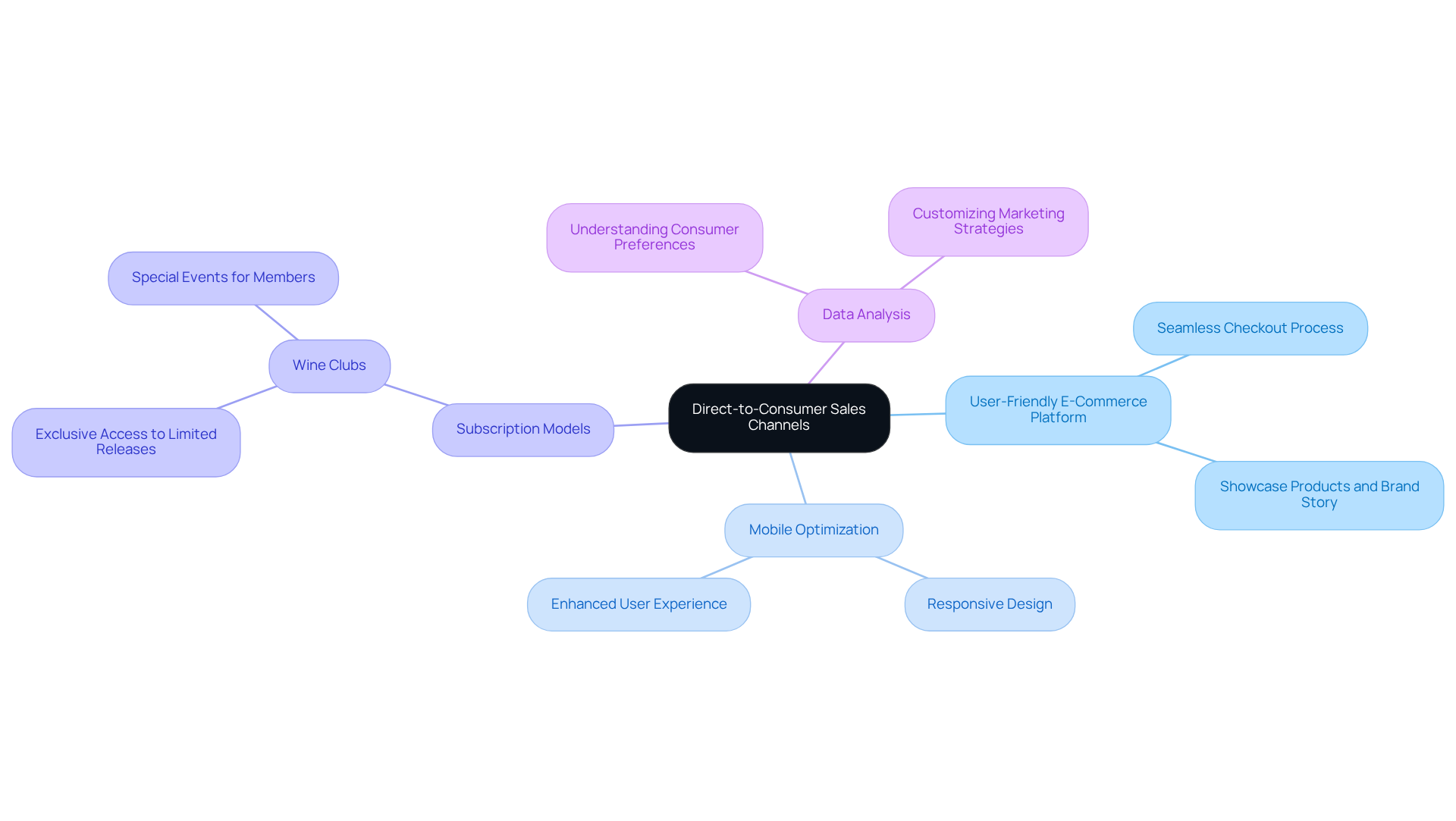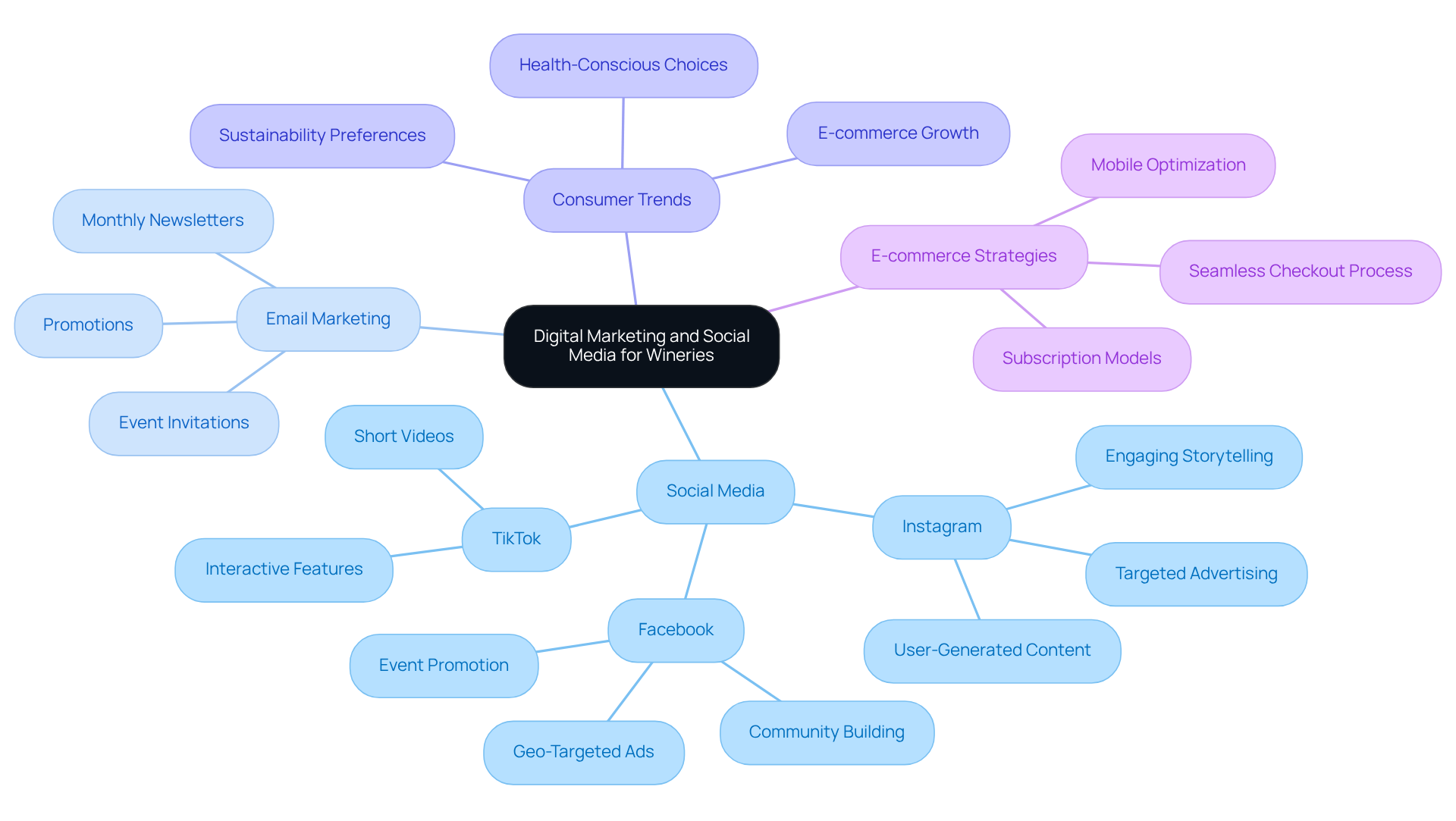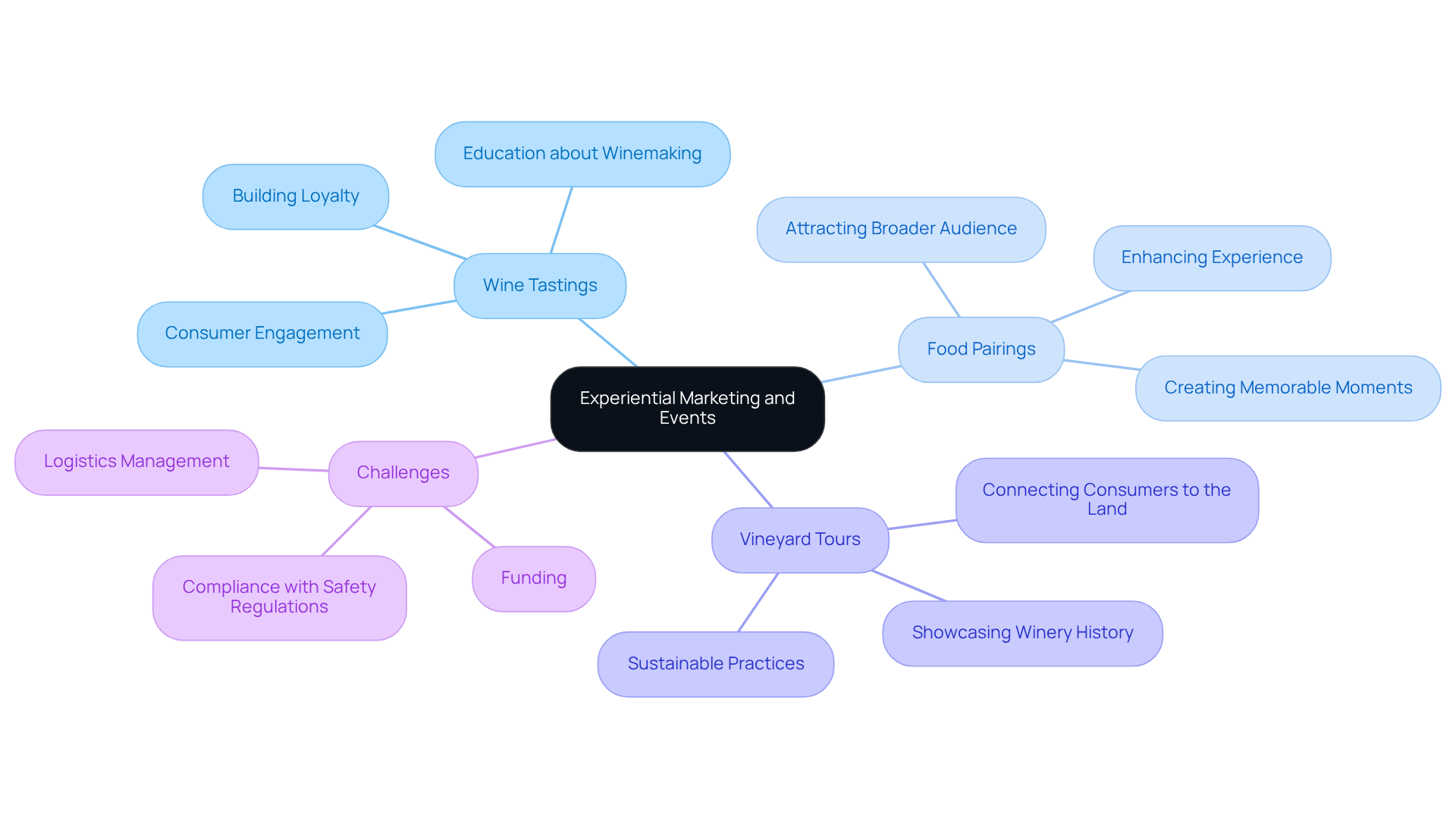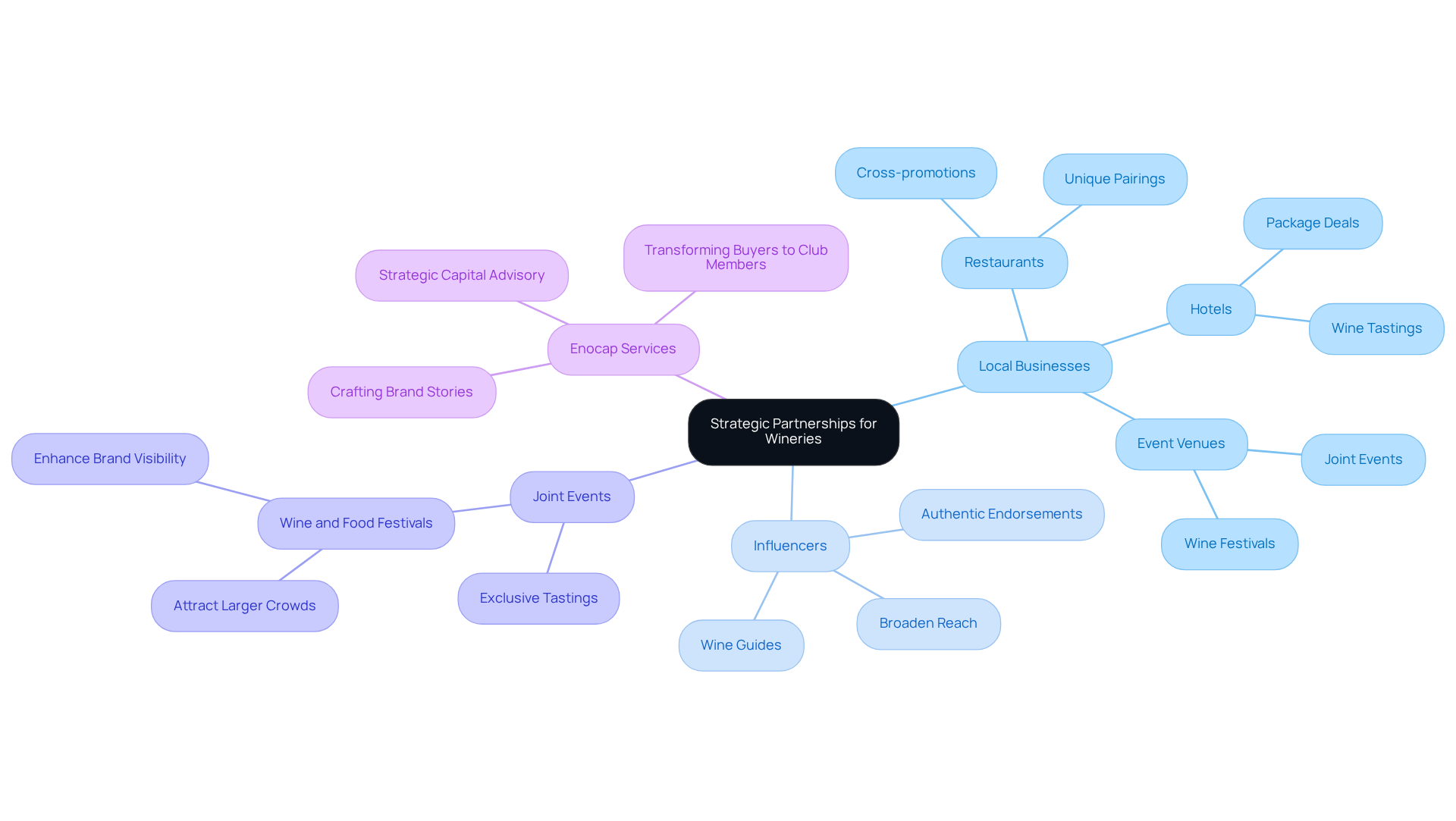Overview
The article presents four proven marketing strategies that wineries can implement to significantly boost sales and enhance customer loyalty. These strategies focus on:
- Direct-to-consumer sales channels
- Digital marketing
- Experiential marketing
- Strategic partnerships
By leveraging these approaches, wineries can enhance customer engagement through tailored experiences, establish a robust online presence, and forge collaborations that expand their reach. Ultimately, these efforts drive repeat purchases and foster enduring brand loyalty.
Introduction
In an industry as rich and competitive as winemaking, standing out requires not just exceptional products but also innovative marketing strategies. Wineries are increasingly recognizing the importance of direct-to-consumer sales channels, digital marketing, and experiential events to enhance customer loyalty and drive sales. This article explores four proven marketing strategies that can empower wineries to flourish in a rapidly evolving market.
How can these approaches transform casual wine enthusiasts into devoted patrons? Furthermore, what challenges must be navigated to achieve lasting success?
Develop Direct-to-Consumer Sales Channels
To effectively cultivate direct-to-consumer (DTC) sales channels, wineries must prioritize the development of a user-friendly e-commerce platform. This platform should not only showcase their products but also , capturing the essence of what they offer.
Optimizing the website for mobile devices and ensuring a seamless checkout process is essential for enhancing user experience. Implementing subscription models, such as wine clubs, can significantly boost repeat purchases and encourage loyalty among patrons.
For instance, vineyards can offer exclusive access to limited releases or special events for club members, thereby increasing the perceived value of membership. Furthermore, utilizing data analysis to understand consumer preferences and buying behaviors allows vineyards to effectively customize their products and strategies for marketing for wine.
This method not only drives sales growth but also improves client retention, positioning vineyards for ongoing success in a competitive market.

Leverage Digital Marketing and Social Media
Wineries must leverage the potential of social media platforms such as Instagram and Facebook for marketing for wine by presenting visually compelling content that highlights their wines, vineyards, and winemaking processes. Engaging storytelling is crucial; it not only captivates audiences but also encourages shares, thereby broadening reach. Targeted advertising on these platforms allows producers to connect with specific demographics, effectively driving traffic to their websites.
Email marketing for wine remains a vital strategy; vineyards can develop tailored campaigns that offer promotions, share updates, and invite patrons to events. For example, a vineyard might distribute a monthly newsletter featuring new releases, upcoming tastings, and exclusive discounts. This strategy cultivates a sense of community and promotes repeat visits, reinforcing customer loyalty.
As we look toward 2025, trends indicate that nearly 90% of global consumers utilize social media to stay informed about cultural trends, making it imperative for vineyards to incorporate marketing for wine strategies that align with these platforms. Successful campaigns frequently incorporate interactive elements, such as polls and quizzes, to actively engage followers. By sharing behind-the-scenes content and collaborating with local influencers, vineyards can enhance authenticity and forge deeper connections with their audience.
Furthermore, as e-commerce continues to expand, optimizing websites for mobile shopping and ensuring a seamless checkout process are essential for converting online interest into sales. Wineries that adopt these strategies for marketing for wine, coupled with , are well-positioned to excel in an increasingly competitive landscape.

Implement Experiential Marketing and Events
Wineries have a unique opportunity to significantly through a diverse array of activities, such as wine tastings, food pairings, and vineyard tours. These engaging experiences not only showcase the wines but also educate participants about the winery's rich history and intricate winemaking methods, weaving a captivating narrative that resonates with consumers. For instance, hosting a seasonal harvest gathering allows guests to partake in grape picking, followed by tastings of the wines crafted from that very harvest. Collaborating with local chefs for curated food pairings can elevate the experience, attracting a broader audience and creating memorable moments that transform casual buyers into loyal club members.
To maximize participation and generate enthusiasm around the vineyard, effective marketing for wine through social media platforms and targeted email campaigns is essential. Compelling narratives that highlight the vineyard's unique journey and unwavering dedication to quality can further enhance the appeal of these occasions. As buyers increasingly seek authentic encounters, vineyards that prioritize experiential promotion are likely to observe a favorable impact on sales and customer loyalty in 2025 and beyond. Furthermore, integrating sustainable practices during events can resonate with the growing demographic of environmentally conscious customers, further enhancing the establishment's allure. As Liz Thach, MW, notes, consumers desire genuine experiences that connect them to the land and the winemaking process. However, vineyards must also be cognizant of potential challenges, such as managing logistics for gatherings and ensuring compliance with safety regulations, to effectively implement these transformative strategies. Additionally, securing appropriate funding for these initiatives can aid vineyards in maintaining and expanding their direct-to-consumer channels.

Forge Strategic Partnerships and Collaborations
Wineries must proactively pursue partnerships with local businesses—such as restaurants, hotels, and event venues—to unlock cross-promotional opportunities and establish sustainable . By collaborating with a local restaurant to feature selections from the vineyard on their menu, wineries can create unique pairings that elevate both the culinary and wine experience. Additionally, engaging with influencers or wine bloggers can significantly broaden a vineyard's reach, as these authentic endorsements resonate with new audiences. Joint events, including wine and food festivals, not only attract larger crowds but also enhance brand visibility through marketing for wine efforts.
Leveraging Enocap's strategic capital advisory services can further empower vineyards to enhance these partnerships by crafting compelling brand stories that resonate with consumers. Moreover, strategic capital planning can assist vineyards in transforming casual buyers into dedicated club members, ensuring long-term growth and customer loyalty. By harnessing each other's strengths, wineries can improve their marketing for wine to create compelling experiences that benefit all parties involved, ultimately driving sales.

Conclusion
The wine industry stands at a pivotal moment where innovative marketing strategies can significantly impact sales and customer loyalty. Wineries must adapt to the evolving market landscape by embracing direct-to-consumer sales channels. This approach not only fosters personalized shopping experiences that resonate with consumers but also drives repeat purchases and cultivates brand loyalty. By focusing on these strategies, wineries position themselves for immediate success while laying the groundwork for long-term growth in a highly competitive industry.
Key tactics such as:
- Leveraging digital marketing
- Engaging on social media
- Hosting experiential marketing events
- Forming strategic partnerships
are essential for building a robust marketing framework. Visually appealing content and interactive storytelling on social media platforms captivate audiences, while experiential events forge authentic connections that deepen customer relationships. Collaborations with local businesses and influencers amplify visibility and create unique experiences that attract new customers.
Wineries are encouraged to embrace these proven tactics and continuously adapt to consumer preferences. By investing in direct-to-consumer channels, engaging storytelling, and strategic collaborations, wineries can boost their sales and cultivate a loyal customer base poised to thrive well into the future. The time to act is now—implement these strategies to elevate your winery's presence and success in the market.
Frequently Asked Questions
What is the primary focus for wineries looking to develop direct-to-consumer sales channels?
Wineries should prioritize the development of a user-friendly e-commerce platform that showcases their products and narrates their brand story.
Why is it important to optimize the website for mobile devices?
Optimizing the website for mobile devices is essential for enhancing user experience and ensuring a seamless checkout process.
How can subscription models benefit wineries?
Subscription models, such as wine clubs, can significantly boost repeat purchases and encourage loyalty among patrons.
What exclusive benefits can vineyards offer to wine club members?
Vineyards can offer exclusive access to limited releases or special events for club members, increasing the perceived value of membership.
How can data analysis help wineries in their marketing strategies?
Utilizing data analysis allows vineyards to understand consumer preferences and buying behaviors, enabling them to customize their products and marketing strategies effectively.
What are the overall benefits of implementing these strategies for wineries?
These strategies drive sales growth, improve client retention, and position vineyards for ongoing success in a competitive market.




